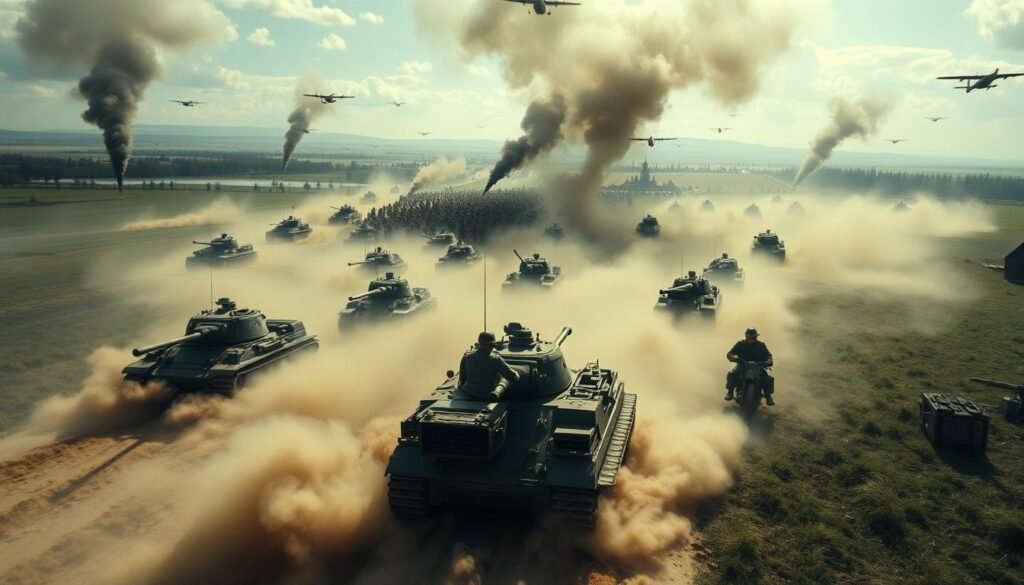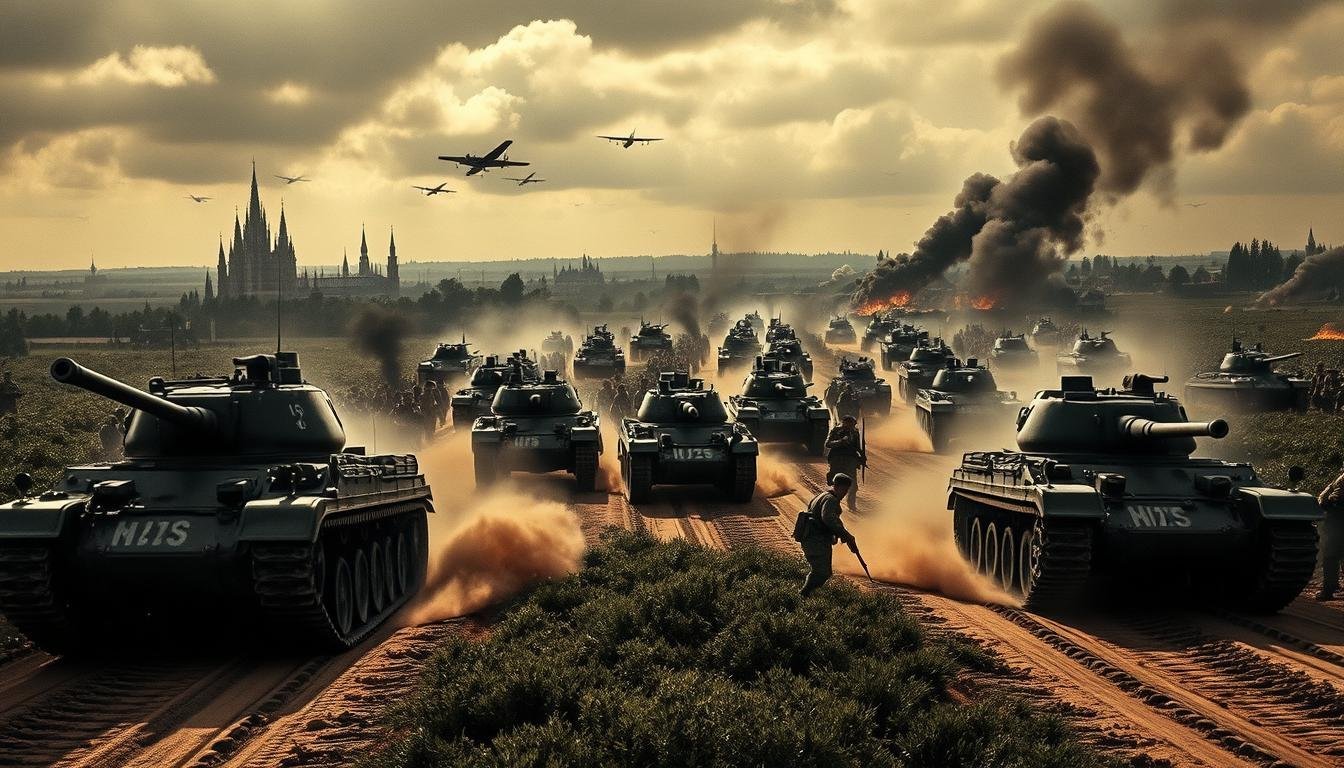How Hitler Conquered Poland? You are about to uncover the surprising tactics Hitler employed to invade Poland, marking the beginning of World War II.
On September 1, 1939, Nazi Germany, under Adolf Hitler’s leadership, launched a military invasion that would change the course of history.
The Blitzkrieg approach, which translates to “lightning war,” was a novel tactic. It combined air power, armored units, and infantry to quickly break through enemy defenses.
As you explore this article, you will gain a deeper understanding of how this military strategy was executed and its impact on the world.
Contents
- 1 The Historical Context Leading to the Invasion
- 2 What Strategy Did Hitler Use to Conquer Poland?
- 3 The Role of Air Power in Blitzkrieg
- 4 The Execution of the Invasion Plan
- 5 Why Poland Fell in Just 35 Days
- 6 Conclusion: How Hitler Conquered Poland?
- 7 FAQ
- 7.1 What was the Blitzkrieg strategy used by Hitler to conquer Poland?
- 7.2 What was the significance of the Molotov-Ribbentrop Pact in the invasion of Poland?
- 7.3 How did the German air force contribute to the success of the Blitzkrieg strategy?
- 7.4 What were the main reasons behind Poland’s rapid defeat?
- 7.5 What were the broader implications of the invasion of Poland?
- 7.6 How long did it take for Germany to conquer Poland?
The Historical Context Leading to the Invasion
To understand why Hitler invaded Poland, we must look at the historical background. The late 1930s saw rising tensions in Europe. This was due to the harsh penalties Germany faced after World War I. The Treaty of Versailles caused widespread resentment in Germany, which Hitler used to gain power.
Hitler started his aggressive expansion by annexing Austria in 1938. Then, he occupied the Sudetenland, a part of Czechoslovakia with many Germans. Western powers, like Britain and France, appeased him, hoping to avoid war. They thought this would show Hitler’s weakness.
The Molotov-Ribbentrop Pact was a key factor leading to Poland’s invasion. This pact, signed in August 1939, was between Germany and the Soviet Union. It had a secret part that divided Eastern Europe between the two. This made it clear that Poland was at risk, with no help from the Soviet Union.
The start of WWII is closely tied to Nazi Germany’s expansion and the world’s failure to stop Hitler. Knowing this history helps us understand the complex events leading to World War II.
Hitler’s plan was not just to expand territory. It was also to take advantage of the weaknesses of the post-World War I world. The invasion of Poland was the start of WWII, a war that changed the world.
What Strategy Did Hitler Use to Conquer Poland?
You might wonder how Hitler conquered Poland so quickly. The answer is Blitzkrieg tactics.Blitzkrieg means “lightning war.” It’s a fast and surprising military strategy that quickly beats enemy defenses.
Hitler’s forces used air power, armor, and infantry in Poland. The German air force, the Luftwaffe, was key. It supported ground troops, destroyed Polish airfields, and cut off communication lines.
The Role of Air Power in Blitzkrieg
The Luftwaffe was crucial in Blitzkrieg’s success. It controlled the skies, giving constant air support to German troops. This weakened Polish defenses and let armored divisions push through.

Good teamwork between air power, armor, and infantry made Blitzkrieg work. The Luftwaffe supported, tanks and infantry broke through, and infantry secured the ground.
Hitler’s Blitzkrieg in Poland was very effective. It led to a quick victory. This strategy would shape military tactics for years.
The Execution of the Invasion Plan
The invasion plan was a brilliant example of military strategy. German forces quickly took over Polish defenses. On September 1, 1939, German troops entered Poland, starting a bombing campaign against key cities and infrastructure.
The initial attack aimed to weaken Poland’s resistance. German forces, despite being outnumbered in some areas, used combined arms teams to break through. This tactical move was key to their quick victory.
As the invasion went on, the German military adjusted their strategy as needed. They used Blitzkrieg tactics, which surprised the Polish forces with their speed and movement.
The invasion was a well-coordinated effort, with all German military branches working together. The Luftwaffe was crucial, weakening Polish defenses before ground troops arrived.
Nazi Germany’s strategy was fast and well-coordinated. German forces quickly broke through Polish lines, moving deep into the country.
The execution of the invasion plan was a major reason for Poland’s defeat. The German military’s ability to adapt and adjust their strategy was crucial to their success.
Why Poland Fell in Just 35 Days
Looking back at 1939, it’s clear Poland’s defense was weak. The German Blitzkrieg, using air power, tanks, and infantry, surprised the Polish army.
The Polish military fought bravely but was not ready for the German speed. The lack of coordination between different branches of the armed forces further exacerbated the situation. This made Poland’s defense weak and unable to stop the German plan.
Poland’s defeat was also due to a big difference in military technology and tactics. The Germans had modern tanks, planes, and guns. Poland’s military had old equipment. This made the German army move fast, winning key battles and taking Warsaw, Poland’s capital.
| Factor | Poland’s Defense | German Forces |
|---|---|---|
| Military Tactics | Outdated, static defenses | Modern Blitzkrieg strategy |
| Equipment | Inadequate, outdated hardware | Modern tanks, aircraft, artillery |
| Coordination | Lack of coordination between branches | Highly coordinated efforts |
The fall of Poland in just 35 days showed the need for modern military forces and smart tactics. Poland’s defeat was not just because of German strength. It was also because of Poland’s weak defense strategy.
Conclusion: How Hitler Conquered Poland?
Hitler’s invasion of Poland started World War II. It drew in other major powers, leading to a deadly conflict. Nazi Germany’s success was due to Blitzkrieg tactics, which changed military strategies worldwide.
The lessons from Poland’s fall are still important today. They show the need for adaptability, strategic planning, and readiness against threats. Reflecting on this moment, we see the dangers of not acting quickly enough.
The impact of Nazi Germany’s actions and Blitzkrieg tactics is a warning. It reminds us to stay alert and ready to face new threats. This way, we make sure history’s lessons are not forgotten.
See Also: What Bad Things Did Hitler Do?
FAQ
What was the Blitzkrieg strategy used by Hitler to conquer Poland?
The Blitzkrieg, or “lightning war,” was a new way of fighting. It mixed air power, armored units, and infantry. This allowed the German army to quickly win battles and conquer Poland fast.
What was the significance of the Molotov-Ribbentrop Pact in the invasion of Poland?
The Molotov-Ribbentrop Pact was a deal between Germany and the Soviet Union. It made sure the Soviet Union wouldn’t help Poland. This gave Hitler the courage to start the invasion.
How did the German air force contribute to the success of the Blitzkrieg strategy?
The Luftwaffe, Germany’s air force, was key to the Blitzkrieg. It supported ground troops, destroyed Polish airfields, and cut off communication. This was vital for the German victory.
What were the main reasons behind Poland’s rapid defeat?
Poland lost quickly because of old tactics, bad equipment, and poor coordination. The German Blitzkrieg strategy took advantage of these weaknesses.
What were the broader implications of the invasion of Poland?
The invasion of Poland started World War II. It brought in other big countries and led to a very deadly war. The Blitzkrieg changed military tactics around the world.
How long did it take for Germany to conquer Poland?
Germany took only 35 days to conquer Poland. The capital, Warsaw, fell to the Germans.

Jayceon Schaefer, a social worker from Wailuku, Hawaii, is passionate about history. He created HitlerTruths.com to share his deep interest in Adolf Hitler and explore complex historical topics through writing.

